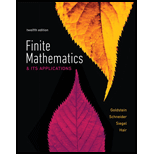
Concept explainers
Nontransitive Dice Consider three dice: one red, one blue, and one green. The sides of the red die contain the numbers 3 3 3 3 3 6, the sides of the blue die contain the numbers 2 2 2 5 5 5, and the sides of the green die contain the numbers 1 4 4 4 4 4.
(a) Determine the probability that the red die will show a higher number than the blue die when both are tossed.
(b) Determine the probability that the blue die will show a higher number than the green die when both are tossed.
(c) Determine the probability that the green die will show a higher number than the red die when both are tossed.
(d) What is surprising about the results in parts (a)–(c)?
Want to see the full answer?
Check out a sample textbook solution
Chapter 6 Solutions
MyLab Math plus Pearson eText -- Standalone Access Card -- for Finite Mathematics & Its Applications (12th Edition)
Additional Math Textbook Solutions
Finite Mathematics for Business, Economics, Life Sciences and Social Sciences
Pathways To Math Literacy (looseleaf)
Precalculus
Elementary and Intermediate Algebra: Concepts and Applications (7th Edition)
Introductory Statistics
Elementary Algebra For College Students (10th Edition)
- || 38 5층-11- 6 4 7 2 6arrow_forward4. Consider the initial value problem y' = 3x(y-1) 1/3, y(xo) = yo. (a) For what points (co, yo) does the IVP have a solution? (b) For what points (xo, yo) does the IVP have a unique solution on some open interval that contains 20? (c) Solve the IVP y' = 3x(y-1) 1/3, y(0) = 9 and determine the largest open interval on which this solution is unique.arrow_forwardFind the limit. (If the limit is infinite, enter 'oo' or '-o', as appropriate. If the limit does not otherwise exist, enter DNE.) lim X→ ∞ (✓ 81x2 - 81x + x 9x)arrow_forward
- Please solve the following Statistics and Probability Problem (show all work) : The probability that a patient recovers from a rare blood disease is 0.4 and 10 people are known to havecontracted this disease. Let X denote the random variable which denotes the number of patient who survivefrom the disease.1. Plot the probability mass function (pmf) of X.2. Plot the cumulative distribution function (cdf) of X.3. What is the probability that at least 8 survive, i.e., P {X ≥ 8}?4. What is the probability that 3 to 8 survive, i.e., P {3 ≤ X ≤ 8}?arrow_forwardthink about what you know about measurements. fill in each box. use words, numbers, and pictures. Show as many ideas as you can.arrow_forwardPlease solve the following Probability and Statistics problem (show all work and double check solution is correct): Suppose that a die is rolled twice. What are the possible values that the following random variables can take1. the maximum value to appear in the two rolls;2. the value of the first roll minus the value of the second roll?3. Calculate the probabilities associated with the above two random variables?arrow_forward
- Please solve the following statistics and probability problem (show all work) : This problem is to show that determining if two events are independent is not always obvious.1. Consider a family of 3 children. Consider the following two events. A is the event that the familyhas children of both sexes and B is the event that there is at most one girl. Are events A and Bindependent?2. What is the answer in a family with 4 children?arrow_forwardPlease solve the following Probability and Statistics problems: (show all work) Suppose that a die is rolled twice. What are the possible values that the following random variables can take1. the maximum value to appear in the two rolls;2. the value of the first roll minus the value of the second roll?3. Calculate the probabilities associated with the above two random variables?arrow_forwardPlease solve the following Statistics and Probability Problem (show all work) : The probability that a patient recovers from a rare blood disease is 0.4 and 10 people are known to havecontracted this disease. Let X denote the random variable which denotes the number of patient who survivefrom the disease.1. Plot the probability mass function (pmf) of X.2. Plot the cumulative distribution function (cdf) of X.3. What is the probability that at least 8 survive, i.e., P {X ≥ 8}?4. What is the probability that 3 to 8 survive, i.e., P {3 ≤ X ≤ 8}?arrow_forward
- 2) Compute the following anti-derivative. √1x4 dxarrow_forwardPlease solve the following Probability and Statistics problem (please double check solution and provide explanation): A binary communication channel carries data as one of two types of signals denoted by 0 and 1. Owing tonoise, a transmitted 0 is sometimes received as a 1 and a transmitted 1 is sometimes received as a 0. For agiven channel, assume a probability of 0.94 that a transmitted 0 is correctly received as a 0 and a probability0.91 that a transmitted 1 is received as a 1. Further assume a probability of 0.45 of transmitting a 0. If asignal is sent, determine 1. Probability that a 1 is received2. Probability that a 0 is received3. Probability that a 1 was transmitted given that a 1 was received4. Probability that a 0 was transmitted given that a 0 was received5. Probability of an errorarrow_forward1) Compute the inverse of the following matrix. 0 1 1 A = 5 1 -1 2-3 -3arrow_forward
 Algebra and Trigonometry (MindTap Course List)AlgebraISBN:9781305071742Author:James Stewart, Lothar Redlin, Saleem WatsonPublisher:Cengage Learning
Algebra and Trigonometry (MindTap Course List)AlgebraISBN:9781305071742Author:James Stewart, Lothar Redlin, Saleem WatsonPublisher:Cengage Learning Algebra & Trigonometry with Analytic GeometryAlgebraISBN:9781133382119Author:SwokowskiPublisher:Cengage
Algebra & Trigonometry with Analytic GeometryAlgebraISBN:9781133382119Author:SwokowskiPublisher:Cengage College AlgebraAlgebraISBN:9781305115545Author:James Stewart, Lothar Redlin, Saleem WatsonPublisher:Cengage Learning
College AlgebraAlgebraISBN:9781305115545Author:James Stewart, Lothar Redlin, Saleem WatsonPublisher:Cengage Learning Holt Mcdougal Larson Pre-algebra: Student Edition...AlgebraISBN:9780547587776Author:HOLT MCDOUGALPublisher:HOLT MCDOUGAL
Holt Mcdougal Larson Pre-algebra: Student Edition...AlgebraISBN:9780547587776Author:HOLT MCDOUGALPublisher:HOLT MCDOUGAL Elementary Linear Algebra (MindTap Course List)AlgebraISBN:9781305658004Author:Ron LarsonPublisher:Cengage Learning
Elementary Linear Algebra (MindTap Course List)AlgebraISBN:9781305658004Author:Ron LarsonPublisher:Cengage Learning





